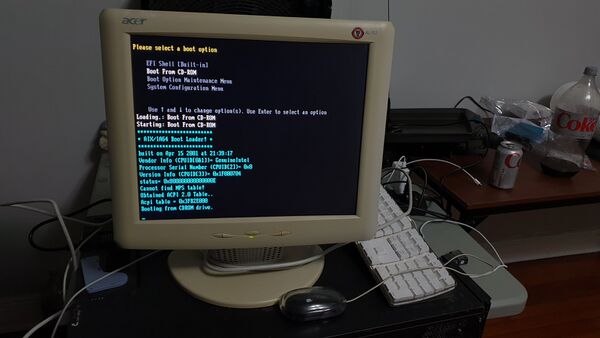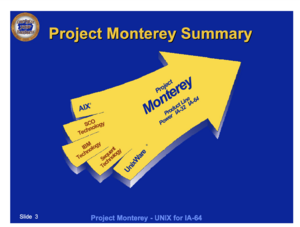AIX on Itanium: Difference between revisions
Dr. Shuppet (talk | contribs) The company that worked together with IBM on Project Monterey was named Santa Cruz Operation (SCO in short). The SCO Group is a name adopted by Caldera International after buying the aforementioned company, which didn't occur until 2001. |
Dr. Shuppet (talk | contribs) Added basic current boot status information |
||
| Line 19: | Line 19: | ||
== Current Boot Status == | == Current Boot Status == | ||
Booting was attempted on several Itanium machines, mostly servers from the HP Integrity line, featuring the zx1 chipset and Itanium 2 CPUs<ref>https://www.openpa.net/systems</ref>, and Compaq ProLiant DL590/64, featuring Itanium 1 CPUs and the Intel 82460GX chipset<ref>https://support.hpe.com/hpesc/public/docDisplay?docId=emr_na-c00409158</ref> (the latter being shared with the aforementioned HP i2000<ref>https://www.openpa.net/systems/hp_i2000.html</ref>). | |||
From the Integrity line, rx1620 and rx2620 were tested. Both go through the bootloader menu and start to load the kernel, but hang on a message referencing changing pProcLocalAPIC->len. Surprisingly, the closely related HP workstation zx6000, which is the predecessor of rx2600<ref>https://www.openpa.net/systems/hp_rx2600_rx2620.html</ref>, hangs before displaying the bootloader menu at a message saying "Booting from CDROM drive". | |||
Booting on Compaq ProLiant DL590/64 gets further, likely thanks to it sharing its chipset with the HP i2000. However, the kernel fails to start, displaying various errors onto the serial console, including one about ID_SALCB_GETMEDIAINFO callback error (Could not load UNDI. Status = Not Found) and several console-IO-related variables missing (ConInDev, ConOutDev, ErrOutDev, ConOut, ConIn, ErrOut). | |||
== Get Involved == | == Get Involved == | ||
Revision as of 09:57, 2 September 2022

IBM's own flavor of UNIX, known as AIX has long been relegated to a handful of IBM's own hardware, most of which has been built around the PowerPC processor architecture. However, IBM, in combination with SCO, worked to create a port of AIX to Itanium. This page documents current known information, attempts to boot, historical context, and more combining everything we known up to this point.
Right now, the dumped images do not boot on any available hardware, nor is there any emulator available. It appears to only be usable with Intel's original Merced Software Development Vehicle, and the HP i2000, both very rare pieces of hardware. However, there's some hope it might be possible to boot it on something else ...
Project Monterey

In the mid to late 90s, IBM, along with SCO looked at creating a new version of UNIX to act as a common base for UNIX on Intel's new 64-bit platform.[1]. The idea was that there would be a common core, creating the basis of the next System V release, which would then be licensed and branded by any interested parties.
With Itanium slated to be the successor of DEC Alpha, PA-RISC, and POWER, there was hope that UNIX would be successful on the new platform. For their part, HP-UX was ported to Itanium, and it's known that, Sun[2] also looked at porting Solaris to Itanium. However, the unexpected success of Linux displaced most of these plans, with IBM eventually embracing Linux.[3]
This set the group for the later IBM vs SCO lawsuits, which partially alleged that IBM included components from Project Monterey, and included them in Linux. What is known from the case files is that there was very little demand for Project Monterey[4], although it's not entirely clear if that's due to the relatively low adoption of Itanium in general, or due to the availability of HP-UX and Linux on the platform.
In mid-2022, a 2001 archive of the Project Monterey disks was uploaded to the Internet Archive, and NCommander did some initial explorations of it, forming the initial basis of knowledge.
NCommander's Initial Explorations
Current Boot Status
Booting was attempted on several Itanium machines, mostly servers from the HP Integrity line, featuring the zx1 chipset and Itanium 2 CPUs[5], and Compaq ProLiant DL590/64, featuring Itanium 1 CPUs and the Intel 82460GX chipset[6] (the latter being shared with the aforementioned HP i2000[7]).
From the Integrity line, rx1620 and rx2620 were tested. Both go through the bootloader menu and start to load the kernel, but hang on a message referencing changing pProcLocalAPIC->len. Surprisingly, the closely related HP workstation zx6000, which is the predecessor of rx2600[8], hangs before displaying the bootloader menu at a message saying "Booting from CDROM drive".
Booting on Compaq ProLiant DL590/64 gets further, likely thanks to it sharing its chipset with the HP i2000. However, the kernel fails to start, displaying various errors onto the serial console, including one about ID_SALCB_GETMEDIAINFO callback error (Could not load UNDI. Status = Not Found) and several console-IO-related variables missing (ConInDev, ConOutDev, ErrOutDev, ConOut, ConIn, ErrOut).
Get Involved
References
- ↑ http://www.csee.umbc.edu/help/architecture/idfmontereylab.pdf
- ↑ https://www.zdnet.com/article/sun-boots-solaris-on-itanium-hardware-5000103621/
- ↑ https://www.cnet.com/tech/tech-industry/ibm-to-spend-1-billion-on-linux-in-2001/
- ↑ http://www.groklaw.net/article.php?story=2005082506163768
- ↑ https://www.openpa.net/systems
- ↑ https://support.hpe.com/hpesc/public/docDisplay?docId=emr_na-c00409158
- ↑ https://www.openpa.net/systems/hp_i2000.html
- ↑ https://www.openpa.net/systems/hp_rx2600_rx2620.html